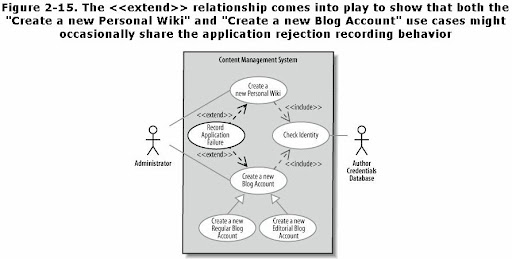|
Use case description detail |
What the detail means and why it is useful |
|---|---|
|
Related Requirements |
Some indication as to which requirements this use case partially or completely fulfills. |
|
Goal In Context |
The use case's place within the system and why this use case is important. |
|
Preconditions |
What needs to happen before the use case can be executed. |
|
Successful End Condition |
What the system's condition should be if the use case executes successfully. |
|
Failed End Condition |
What the system's condition should be if the use case fails to execute successfully. |
|
Primary Actors |
The main actors that participate in the use case. Often includes the actors that trigger or directly receive information from a use case's execution. |
|
Secondary Actors |
Actors that participate but are not the main players in a use case's execution. |
|
Trigger |
The event triggered by an actor that causes the use case to execute. |
|
Main Flow |
The place to describe each of the important steps in a use case's normal execution. |
|
Extensions |
A description of any alternative steps from the ones described in the Main Flow. |
Example:
|
Use case name |
Create a new Blog Account | ||
|---|---|---|---|
|
Related Requirements |
Requirement A.1. | ||
|
Goal In Context |
A new or existing author requests a new blog account from the Administrator. | ||
|
Preconditions |
The system is limited to recognized authors and so the author needs to have appropriate proof of identity. | ||
|
Successful End Condition |
A new blog account is created for the author. | ||
|
Failed End Condition |
The application for a new blog account is rejected. | ||
|
Primary Actors |
Administrator. | ||
|
Secondary Actors |
Author Credentials Database. | ||
|
Trigger |
The Administrator asks the CMS to create a new blog account. | ||
|
Main Flow |
Step |
Action | |
|
1 |
The Administrator asks the system to create a new blog account. | ||
|
2 |
The Administrator selects an account type. | ||
|
3 |
The Administrator enters the author's details. | ||
|
4 |
The author's details are verified using the Author Credentials Database. | ||
|
5 |
The new blog account is created. | ||
|
6 |
A summary of the new blog account's details are emailed to the author. | ||
|
Extensions |
Step |
Branching Action | |
|
|
4.1 |
The Author Credentials Database does not verify the author's details. | |
|
|
4.2 |
The author's new blog account application is rejected. | |







 本文深入解析UML 2.0中的用例图,介绍如何定义用例及其关键要素,如目标上下文、前置条件、成功与失败的结束条件等,并通过创建新的博客账户这一实例详细说明了用例描述的构成。
本文深入解析UML 2.0中的用例图,介绍如何定义用例及其关键要素,如目标上下文、前置条件、成功与失败的结束条件等,并通过创建新的博客账户这一实例详细说明了用例描述的构成。

















 被折叠的 条评论
为什么被折叠?
被折叠的 条评论
为什么被折叠?








